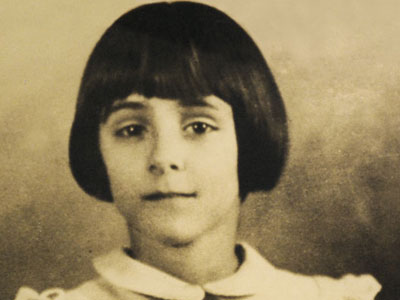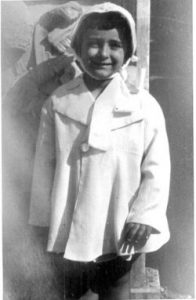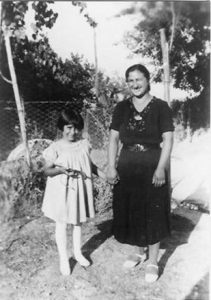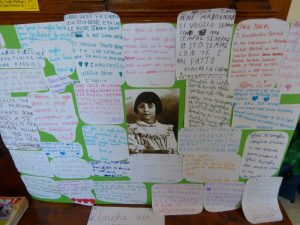
Venerable Antonietta Meo was a twentieth-century child who lived a life of great spiritual depth and could become the youngest non-martyr ever canonized by the Catholic Church. Antonietta was born in Rome in 1930 to Michele and Maria Meo, their second and youngest daughter. She was known to all as “Nennolina”.

Happy, playful child
At age three, she began at a nursery school staffed by religious sisters, and enjoyed it a great deal. She was well liked for her outgoing personality and cheerfulness. At age four, Nennolina developed a swelling on her left knee, which was assumed to be a typical reaction from the many spills that young children experience while at play. When the swelling increased, a doctor was consulted, who misdiagnosed the condition. At age five, she enrolled in the children’s program for Catholic Action, a group that was popular in early twentieth century Italy. When she was five and a half, the correct diagnosis was finally discovered – osteosarcoma, or cancer of the bone.
Life with cancer

In the spring of 1936, Nennolina’s leg was amputated to halt the spread of the cancer. She was fitted with a prosthetic leg, which was painful and difficult, but which enabled her to hope to return to school. While she was convalescing, she was tutored in the Catechism (probably the Catechism of Pope Pius X, which was published in Italian) by her mother. She also began the unique habit of composing little letters and poems to Jesus or to Mary, who she called “Madonnina” or little Madonna. Nennolina’s mother wrote for her before she was able to write them herself. She placed the letters at the foot of a statue of the Child Jesus in her bedroom, inviting Him to come and read them during the night.
Special First Holy Communion
She was visited by a priest, who was so impressed with her spiritual knowledge and maturity, he suggested that she write to the Mother General of her school’s religious order, to request First Holy Communion at the upcoming Christmas Mass. Nennolina was given permission to receive her First Communion in the nun’s convent chapel on Christmas night 1936. On that night, she was observed spending over an hour on her knees in prayer, still and silent. She was also heard after other Masses to address the tabernacle and say, “Jesus, come and play with me.”
The amputation of Nennolina’s leg did not halt the growth of cancer, which eventually spread to her remaining foot, her hand, and her throat and mouth. She had been able to return to school for a time, learning to write, but after she received the Sacrament of Confirmation in May of 1937, her health took a sharp decline. She began to have a chronic cough, and because of her illnesses and her treatments, was unable to leave her bed. Despite her constant pain, she would always tell her loved ones that she was fine.
Last letter
On June 2, Nennolina composed what would be her last letter to Jesus, which was filled with gratitude and great affection. When a visiting professor examined her for a consultation, Michele told him about the letters. Greatly impressed, the professor took the last letter with him to show to his friend, Pope Pius XI, who also was greatly impressed. The next day, an emissary from the Vatican came to the house, bringing an apostolic blessing and requesting Nennolina’s prayers for the Holy Father. In late June, the tumors in her chest were making breathing so difficult that three ribs had to be removed with only a local anesthetic due to her weakness. She amazed her caregivers by her lack of complaint and her cheerfulness. She died on July 3, 1937, smiling brightly just before her last breath. She was six and a half years old. A shrine to her memory is at the Basilica of the Holy Cross of Jerusalem in Rome, which also houses relics of the cross of Christ.

The letters of Venerable Antonietta “Nennolina” Meo, although childlike, give evidence of a little girl who possessed extraordinary spiritual maturity. Written during a time of declining health and much pain, 177 of the letters, most written in her own hand, still exist. She possessed an understanding of a concept that even most adults grapple with, the true meaning of suffering and its redemptive value. She asked Jesus repeatedly to use her suffering to save many souls, and she concluded all of her letters with kisses, hugs, or caresses. Most of the letters were addressed to Jesus or Mary, but she wrote one each to two other women who died very young: St. Agnes and St. Therese of Lisieux. Because of her membership in Catholic Action, they initiated the cause for her beatification in 1941. In 1981, the Sacred Congregation for the Causes of Saints, after serious consideration, declared that even young children are capable of heroic virtue. In 2007, Pope Benedict XVI accepted a declaration that she lived a life of heroic virtue, and one miraculous healing has already been attributed to her intercession.
